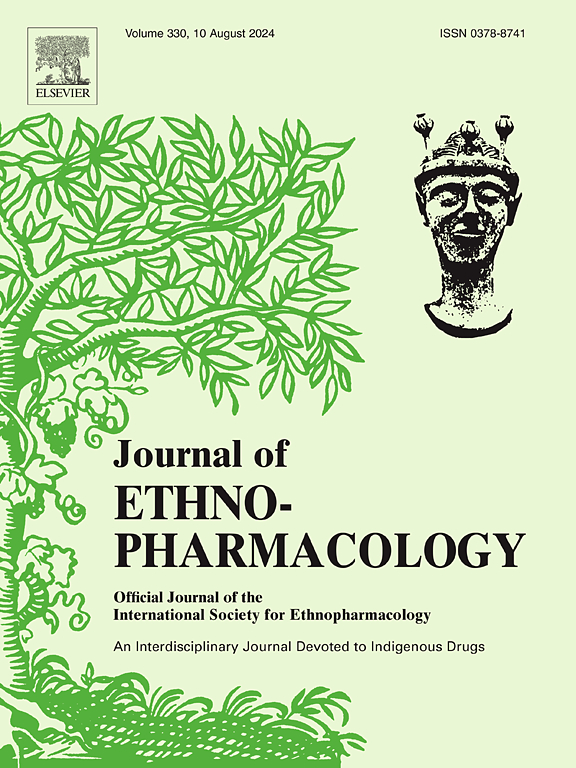补肾益髓胶囊修饰的骨髓间充质干细胞外泌体通过调节miR-15b/Wnt信号通路介导的少突胶质细胞分化促进髓鞘再生的机制
IF 4.8
2区 医学
Q1 CHEMISTRY, MEDICINAL
引用次数: 0
摘要
民族药理学相关性:补肾益髓胶囊(BSYS)是中药复方六味地黄丸的改良版,已被证明具有治疗多发性硬化症(MS)的疗效。然而,BSYS促进髓鞘再生的确切机制仍有待阐明。研究目的:本研究探讨了bsys修饰的骨髓间充质干细胞外泌体(exos)在铜酮(CPZ)诱导的小鼠脱髓鞘模型中促进髓鞘再生的作用及其潜在机制。材料和方法:C57BL/6小鼠连续5周给予含0.2% cpz的饲粮诱导脱髓鞘,然后给予BMSC来源的外泌体(bmscs -exos)和bsys修饰的BMSC外泌体(bsys - bmscs -exos)治疗,每周2次,持续2周。记录体重测量值,并使用旋转杆试验评估运动功能。采用Luxol快速蓝(LFB)染色、透射电镜(TEM)和免疫荧光(IF)染色观察髓磷脂和轴突的病理变化。采用双免疫荧光染色、Western blot (WB)和实时定量反转录PCR (qRT-PCR)分析少突胶质细胞的增殖、分化和成熟情况。此外,进行了microRNA (miRNA)测序和荧光素酶报告基因测定,以验证miRNA与靶基因的结合。采用WB和qRT-PCR检测Wnt/β-catenin信号通路的关键标记。结果:BSYS-BMSC-exos处理能显著提高CPZ小鼠的体重和转轮性能。此外,BMSC-exos和BSYS-BMSC-exos可逆转髓磷脂丢失和轴突损伤。这些处理增强了少突胶质细胞的增殖、分化和成熟,其中BSYS-BMSC-exos对腺瘤性息肉病大肠杆菌克隆CC1 (CC1)、2′,3′-环核苷酸3′-磷酸二酯酶(CNPase)、蛋白脂质蛋白(PLP)、髓鞘少突胶质细胞糖蛋白(MOG)和髓鞘碱性蛋白(MBP)的表达表现出特别显著的影响。测序和荧光素酶分析显示,在BSYS-BMSC-exos中富集的miR-15b-5p直接靶向Wnt3a。此外,BSYS-BMSC-exos提高轴抑制蛋白2 (Axin2)的表达,同时显著降低Wnt家族成员3A (Wnt3a)、磷酸糖原合成酶激酶3β (p-GSK3β)、β-catenin和t细胞特异性转录因子4/转录因子7样2 (TCF4/TCF7L2)的水平。结论:BSYS-BMSC-exos可减轻CPZ小鼠神经功能缺损,促进少突胶质细胞分化成熟,促进髓鞘再生。miR-15b-5p富集于BSYS-BMSC-exos中,靶向并下调Wnt3a,从而抑制Wnt/β-catenin信号通路。本文章由计算机程序翻译,如有差异,请以英文原文为准。

The mechanism of exosomes of BMSCs modified with Bu Shen Yi Sui capsule in promoting remyelination via regulating miR-15b/Wnt signaling pathway-mediated differentiation of oligodendrocytes
Ethnopharmacological relevance
The Bu Shen Yi Sui capsule (BSYS), a modified version of the classical Chinese medicine formula Liu Wei Di Huang pill, has demonstrated therapeutic efficacy in the treatment of multiple sclerosis (MS). Nevertheless, the precise mechanism through which BSYS facilitates remyelination remains to be elucidated.
Aim of the study
This research investigates the role and potential mechanisms of BSYS-modified exosomes (exos) derived from bone marrow mesenchymal stem cells (BMSCs) in promoting remyelination in a cuprizone (CPZ)-induced demyelination model in mice.
Materials and methods
C57BL/6J mice were administered a 0.2% CPZ-containing diet for 5 weeks to induce demyelination, followed by treatment with exosomes derived from BMSC (BMSC-exos) and BSYS-modified BMSC exosomes (BSYS-BMSC-exos) twice weekly for 2 weeks. Body weight measurements were recorded, and motor function was evaluated using the rotarod test. Pathological changes in myelin and axons were assessed via Luxol fast blue (LFB) staining, transmission electron microscopy (TEM), and immunofluorescence (IF) staining. Oligodendrocyte proliferation, differentiation, and maturation were analyzed using IF double-staining, Western blot (WB), and real-time quantitative reverse transcription PCR (qRT-PCR). Additionally, microRNA (miRNA) sequencing and a luciferase reporter assay were conducted to verify miRNA binding to its target gene. Key markers of the Wnt/β-catenin signaling pathway were examined using WB and qRT-PCR.
Results
BSYS-BMSC-exos treatment significantly increased both body weight and rotarod performance in CPZ mice. Moreover, BMSC-exos and BSYS-BMSC-exos reversed myelin loss and axonal damage. These treatments enhanced oligodendrocytes proliferation, differentiation, and maturation, with BSYS-BMSC-exos exhibiting a particularly pronounced effect on the expression of adenomatous polyposis coli clone CC1 (CC1), 2′,3′-cyclic nucleotide 3′-phosphodiesterase (CNPase), proteolipid protein (PLP), myelin oligodendrocyte glycoprotein (MOG), and myelin basic protein (MBP). Sequencing and luciferase assays revealed that miR-15b-5p, enriched in BSYS-BMSC-exos, directly targets Wnt3a. Furthermore, BSYS-BMSC-exos elevated axis inhibition protein 2 (Axin2) expression while markedly reducing Wnt family member 3A (Wnt3a), phospho-glycogen synthase kinase-3β (p-GSK3β), β-catenin, and T-cell specific transcription factor 4/transcription factor 7-like 2 (TCF4/TCF7L2) levels.
Conclusions
The findings suggest that BSYS-BMSC-exos alleviate neurological deficits, enhance oligodendrocytes differentiation and maturation, and promote remyelination in CPZ mice. miR-15b-5p, enriched in BSYS-BMSC-exos, targets and downregulates Wnt3a, thereby inhibiting the Wnt/β-catenin signaling pathway.
求助全文
通过发布文献求助,成功后即可免费获取论文全文。
去求助
来源期刊

Journal of ethnopharmacology
医学-全科医学与补充医学
CiteScore
10.30
自引率
5.60%
发文量
967
审稿时长
77 days
期刊介绍:
The Journal of Ethnopharmacology is dedicated to the exchange of information and understandings about people''s use of plants, fungi, animals, microorganisms and minerals and their biological and pharmacological effects based on the principles established through international conventions. Early people confronted with illness and disease, discovered a wealth of useful therapeutic agents in the plant and animal kingdoms. The empirical knowledge of these medicinal substances and their toxic potential was passed on by oral tradition and sometimes recorded in herbals and other texts on materia medica. Many valuable drugs of today (e.g., atropine, ephedrine, tubocurarine, digoxin, reserpine) came into use through the study of indigenous remedies. Chemists continue to use plant-derived drugs (e.g., morphine, taxol, physostigmine, quinidine, emetine) as prototypes in their attempts to develop more effective and less toxic medicinals.
 求助内容:
求助内容: 应助结果提醒方式:
应助结果提醒方式:


